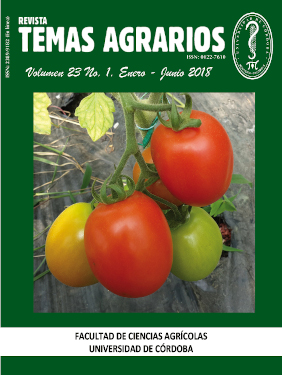Bunches number and economic sustainability of tomato under semi- controlled conditions
Número de racimos y la sostenibilidad económica del tomate bajo condiciones semicontroladas

This work is licensed under a Creative Commons Attribution-NonCommercial 4.0 International License.
Show authors biography
Studies related to tomato productivity regarding the relationship between the elimination of flower clusters and their economic sustainability are scarce. The present study was conducted in order to evaluate the effect of the number of bunches on the yield, quality and profitability of the Torrano® hybrid tomato crop under semi controlled conditions in greenhouses of 12m x 40m (480 m2) for a total area of 960 m2. This was carried out in the Tesorito farm, property of the University of Caldas, Manizales under a design of complete blocks at random with four cut: 6; 8 and 10 bunches / plant and without cut with indeterminate growth, each treatment had six repetitions and the experimental unit was five plants. The quality of the fruit and the yield per plant and per hectare were evaluated. The plants without pruning with indeterminate growth showed the highest values in the different qualities of the fruit like first, second, third and the total yield with values of 2236, 1666, 750 and 6883 g / plant respectively. Equally, genre higher net income with $ 27,241 has / cycle, however in percentage terms quality increases as the number of bunches per plant is reduced. Therefore, it is concluded that clusters should not be pruned in Torrano® hybrid tomato under semicontrolled conditions in the study area.
Article visits 1237 | PDF visits
Downloads
- Anuario meteorológico Cafetero. 2012 y 2013. Federación Nacional de Cafeteros de Colombia. Cenicafé, Chinchiná (Colombia).
- Arbelaez, L., Rivera, J., Hurtado-Salazar, A. y Ceballos Aguirre, N. 2016. Technical and Economic Evaluation of Three Types of Tomato Nutrient Solutions under Semi-Controlled Conditions. Journal of Agricultural Science 8(8): 68-78.
- Bogiani, J., Anton, C., Seleguini, A., Faria, M. y Seno, S. 2008. Poda apical, densidade de plantas e cobertura plástica do solo na produtividade do tomateiro em cultivo protegido. Bragantia, 67(1): 145-151.
- Carvalho, L. y Tessarioli, J. 2005. Produtividade de tomate em ambiente protegido, em função do espaçamento e número de ramos por planta. Horticultura Brasileira 23: 986-989.
- Guimarães, M., Silva, D., Fontes, P., Caliman, F., Loos, R. y Stringheta, P. 2007. Produção e sabor dos frutos de tomateiro submetidos a poda apical e de cachos florais. Horticultura Brasileira 25: 265-269.
- Hachmann, T., Echer, M., Dalastra, G., Vasconcelos, E. y Guimarães, V. 2014. Cultivo do tomateiro sob diferentes espaçamentos entre plantas e diferentes níveis de desfolha das folhas basais. Bragantia 73(4): 399-406.
- Herrera, H., Hurtado-Salazar, A. y Ceballos-Aguirre, N. 2015. Estudio técnico y económico del tomate tipo cereza élite (Solanum lycopersicum L. var. Cerasiforme) bajo condiciones semicontroladas. Revista Colombiana de Ciencias Hortícolas 9(2): 290-300
- Hoyos, J. y Hurtado-Salazar, A. 2017. Poda temprana de brotes laterales en el inicio de la floración de papaya Tainung 1. Temas Agrarios 22(2): 52-58.
- Machado, A., Alvarenga M. y Florentino, C. 2007. Produção de tomate italiano (saladete) sob diferentes densidades de plantio e sistemas de poda visando ao consumo in natura. Horticultura Brasileira 25: 149-153.
- Mendonça, V. y Mendeiros, L. 2011. Importância da fruticultura, poda das árvores frutíferas, propagação das plantas frutíferas. Boletim I. Mossoró, R
- Monteiro, C., Balbi, M., Miguel, O., Penteado, P. y Haracemiv, S. 2008. Qualidade nutricional e antioxidante do tomate “tipo italiano”. Revista Alimentos e Nutrição 19: 25-31.
- Perilla, A. Rodríguez, L. y Bermúdez, L. 2011. Estudio técnico-económico del sistema de producción de tomate bajo invernadero en Guateque, Sutatenza y Tenza (Boyacá). Revista colombiana de ciencias hortícolas, 5(2): 220-232.
- Sánchez-Del Castillo, F., Moreno-Pérez, E., Pineda-Pineda, J., Osuna, J., Rodríguez-Pérez, J. y Osuna-Encino, T. 2014. Producción hidropónica de jitomate (Solanum lycopersicum L.) con y sin recirculación de la solución nutritiva. Agrociencia 48: 185-197.
- Seleguini, A., Seno, S. y Faria M. 2006. Espaçamento entre plantas e número de racimos para tomateiro em ambiente protegido. Acta Scientiarum. Agronomy 28(3): 359-363.
- Streck, N., Buriol, G., Andriolo, J. y Sandri, M. 1998. Influência da densidade de plantas e poda apical drástica na produtividade do tomateiro em estufa de plástico. Pesquisa Agropecuária Brasileira 33: 1105-1112.
- Testa, R., Trapani, A., Sgroi, F. y Tudisca, S. 2014. Economic Sustainability of Italian Greenhouse Cherry Tomato. Sustainability, 6, 7967-7981.
- Wamser A., Mueller S., Becker, W. y Santos, J. 2007. Produção do tomateiro em função dos sistemas de condução de plantas. Horticultura Brasileira 25: 238-243.




















